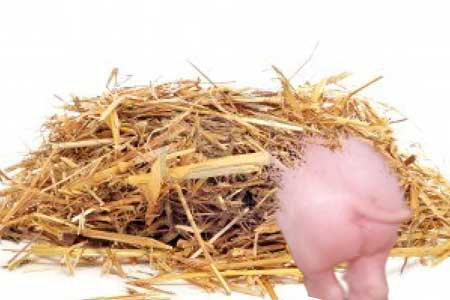How much straw does a pig need?

Researchers at the Aarhus University in Denmark found that a finishing pig needs up to 400g of straw per day to meet its behavioural needs for manipulation and rooting – this not only satisfies behavioural needs but encourages a higher growth rate and the risk of gastric ulcers is reduced.
In 2010 the Ministry of Justice and Ministry of Food, Agriculture and Fisheries jointly commissioned a study from Aarhus University to clarify how much whole straw is needed to satisfy the rooting and manipulation requirements of pigs under practical conditions. The results have been published in a new report from DCA – Danish Centre for Food and Agriculture.
– Danish and EU legislation stipulates that pigs must have permanent access to a sufficient quantity of straw or other manipulable material to enable proper investigative and manipulative behaviour – but there are no specific figures for how much straw is needed, says the main author of the report, senior scientist Lene Juul Pedersen from Aarhus University.
Pigs need activity and novel stimuli
Pigs use much of their active time investigating their surroundings. The behaviour may be motivated by hunger, but finishing pigs, which typically have free access to feed, are primarily motivated by information-seeking and curiosity. Pigs examine a substrate or an environment by behavioural patterns such as sniffing, rooting, pushing, chewing or biting.
Therefore, the pigs in an intensive production situation with free access to feed still need access to manipulable materials (rooting and enrichment materials) that can fulfil this motivation.
If the animals are short of stimuli, they can redirect their normal exploratory behaviour towards the other pigs in the pen, and especially against their ears and tails.
In the project, the scientists therefore used changes in the incidence of exploratory behaviour re-directed at pen mates as an indicator of a lack of fulfilment of the behavioural need. In the study, the following secondary variables were also registered:
• Injuries to the tail
• Daily weight gain
• Quantity of clean straw remaining in the pens (the amount of straw that is left before the next allocation of straw)
• Targets for indoor climate
• Gastric health.
Pigs need up to 400g of whole straw to meet their needs
In the first phase, the scientists examined pig behaviour when they received 10, 500 or 1000 grams straw per pig per day. This showed that there was no difference in the exploratory behaviour re-directed at other pigs for pigs given 500 g and 1000 g straw, but for pigs receiving only 10g there was more exploratory behaviour re-directed at pen mates.
In the second phase, the scientists gave daily allocations of straw per pig of, respectively, 10, 80, 150, 220, 290, 360, 430 and 500 grams. The results showed a significant linear correlation between the amount of straw given and the amount of time the pigs spent on investigative behaviour re-directed at pen mates, since a daily allocation of 500g per pig reduced the active time spent on this behaviour from 10.5% to 8.1% compared to the 10g allocation.
In the attempt to set a lower limit for what constitutes a biologically relevant difference, scientists concluded that under the given experimental conditions the pigs must be allocated at least 400 g of whole straw per pig per day to meet their needs.
The welfare impact of providing straw in such quantities was supported by the secondary variables measured. The results were as follows:
• A significant linear decrease in the percentage of animals with injuries to the tail when allocating increasing amounts of straw (5.9% and 2.8%, respectively, for 10 and 500 grams straw)
• A significant increase in growth rate with increasing straw allocation (1,012 g and 1,060 g per day at 10 and 500 grams straw, respectively)
• Significantly fewer pigs with gastric ulcers when allocating 500 or 1000 g straw per pig per day compared to 10g per pig (7% compared to 33%).
Under the given experimental conditions, which involved two weekly muck-outs and omission of data collected in the two hottest months, the amount of straw allocated did not lead to increased soiling in the pens, dirtying of the pigs or deterioration of the quality of the climate in the pens (temperature and ammonia).
Measuring the amounts of clean straw remaining in the pens showed that under the given conditions, minimum allocation per pig is approx. 80g of straw until they weight about 50kg, approx. 150g until approx. 70kg, whereafter they need more than 290g straw per pig to ensure permanent access to straw.
– Now we have factual knowledge of how much straw is needed to meet pig requirements. Allocation of straw can apparently also improve growth and help solve problems with gastric ulcers. Where results are implemented in practice, it will be necessary to design new housing and manure systems that can handle larger amounts of straw, says Lene Juul Pedersen.
Source: Aarhus University / The report (in Danish)











